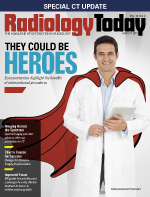 Inside View: Busy Intersection — Specialties Converge With 3D Printing
Inside View: Busy Intersection — Specialties Converge With 3D Printing
By José Morey, MD, and Justine Kemp
Radiology Today
Vol. 18 No. 8 P. 6
3DHEALS, a 3D printing innovation platform, recently brought collaborators from several different specialties together in San Francisco. As founder Hui Jenny Chen, MD, said in her welcoming remarks, "One of the goals of creating this is to see if people from different backgrounds can work together to innovate instead of innovating in a silo." The conference covered the potential and developments of 3D printing, featuring several panels from different specialties, including dentistry, orthopedics, and prosthesis. Chen also noted the significant growth of 3D printing over the past five years, citing the exponential growth of publications related to 3D printing found in PubMed.
3D printing has several applications, from developing personalized parts for a patient to providing simulations to surgeons and residents before surgery. These applications have the potential to drastically reduce health care costs. Paul D'Urso, MBBS, PhD, FRACS, founder of Anatomics, discussed the potential cost savings. By having personalized tools and parts for a patient, the need for extraneous equipment in the operating room decreases, helping reduce waste and costs. Sanjay Prabhu, MBBS, DCH, MRCPCH, FRCR, codirector of SimPeds3D Print Service at Boston Children's Hospital, cited a 7:1 value when using 3D printing for simulations. By having surgeons and residents practice on a simulation before a procedure, morbidity, mortality, and malpractice suits decreased. Thus, for every dollar invested in the 3D printing simulation lab, the hospital saved $7.
Lifelike Models
The conference also aimed to evaluate and discuss the future of 3D printing and its potential intersection with other technologies. Bioprinting and organogenesis are hopeful targets for 3D printing. Keith Murphy, CEO of Organovo, discussed the current implications and future goals of the company, defining bioprinting as "the deposition of human, living cells into a 3D matrix to make a tissue."
Currently, the company has produced liver and kidney tissues, with pharmaceutical companies being major clients. The primary points of use for these tissues include preclinical safety testing of new treatments, disease modeling, and future organ transplant. For the liver tissue, bioprinted models are superior to animal models or harvested hepatocytes, Murphy explained, because their microarchitecture resembles the liver and a "chemical signal interplay" occurs in the tissue matrix. Also, these models survive much longer than individual hepatocytes that have been harvested.
Organovo is now using bioprinting for therapeutic use. Currently, there are limitations in growing full organs due to issues in producing adequate vascularization for the tissues. However, the company is working to make small bioprinted liver tissues that yield approximately 10% of the function of a normal liver. The goal is to use this tissue to give patients some liver function while waiting for transplant.
The conference concluded with potential ways in which 3D printing can intersect with other technologies, such as artificial intelligence, virtual reality, and robotics. Eythor Bender, CEO and cofounder of UNYQ, demonstrated how 3D printing and pressure sensor data are being integrated to make personalized, formfitting scoliosis braces. The data from the pressure sensors indicate whether the brace is touching the right spots on the body and treatment is being optimized.
There is tremendous potential for 3D printing, especially when several different fields have the opportunity to collaborate together. 3DHEALS will have its next meeting on April 20–21, 2018 (www.3dheals2018.com).
— José Morey, MD, is a senior medical scientist for IBM Research, a visiting assistant professor in the department of radiology and medical imaging at the University of Virginia, medical technology and artificial intelligence advisor for NASA iTech, chief engineering counsel for Hyperloop Transportation Technologies, a member of the Health Informatics Leadership Council at the VA, and director of informatics for Medical Center Radiologists in Virginia Beach, Virginia. Find him on Twitter at @DrMorey1.
— Justine Kemp is an MD/MBA candidate at the Tulane University School of Medicine and AB Freeman School of Business in New Orleans. Find her on LinkedIn at http://www.linkedin.com/in/justine-kemp-4408b0109.

